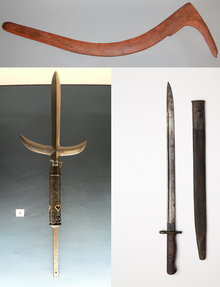Melee weapon

A melee weapon, hand weapon, close combat weapon or fist-load weapon is any handheld weapon used in hand-to-hand combat, i.e. for use within the direct physical reach of the weapon itself, essentially functioning as an additional (and more effective) extension of the user's limbs. By contrast, a ranged weapon is any other weapon capable of engaging targets at a distance beyond immediate physical contact.[1]
Etymology
The term melee originates in the 1640s from the French word mêlée, which refers to disorganized hand-to-hand combat, a close-quarters battle, a brawl, or a confused fight; especially involving many combatants.[2][3][4]
The 1812 tabletop war game Kriegsspiel referred to the hand-combat stage of the game as a melee.[5] Later war games would follow this pattern.[6][7][8] From there, gamers would eventually begin to call the weapons used in that stage melee weapons.[9][10]
Categories
Melee weapons can be broadly divided into three categories:
- Pointed weapons, which cover spears, pikes, lances, and military forks. They typically have a sharp point designed to inflict penetrating trauma, even against heavily armoured opponents, and the length of such weapons gives a range advantage. Certain variants may also hook at enemies to disrupt and disarm them, or pull them from atop horses.
- Edged weapons, which cover laceration, dismemberment, and exsanguinationinjuries, and are most effective against minimally armoured opponents. These are used to cut, hack, slash, thrust or stab.
- Blunt weapons, which cover clubs, maces, war hammers, staves, and flails. These weapons are designed to cause blunt trauma, even through armour that would protect against penetration by pointed or edged weapons.
Many weapons fit into multiple categories, or fit in between them; many polearms such as halberds, lucerne hammers, and guisarmes add edged and blunt methods of attack to a spear base, and various hooked weapons such as billhooks, fauchards, falxes, and becs de corbin evade simple classification; while flexible weapons such as whips don't fall into any of these categories.
List of melee weapons
- Edged and bladed weapons
- Polearms
- Blunt weapons
- Non-lethal weapons
- Ultrasonic Dog Chaser
- Electroshock weapon
- Pepper spray
- Kubotan
- Sports equipment (utilized as an improvised or makeshift melee weapon)
- Hardware and utility tools utilized as improvised melee weapons (often used for criminal purposes, or depicted in fiction)
See also
- Cold weapon
- Melee (gaming)
- Knife fight
- List of premodern combat weapons
- List of martial arts weapons
References
- ^ Michele Byam (2010-11-30). Arms and Armor, Discover the story of weapons and armor-from Stone Age axes to the battledress of samurai warriors. New York: Dorling Kindersley.
- ^ "the definition of melee". Dictionary.com. Archived from the original on 2 March 2021. Retrieved 10 June 2017.
- ^ "Definition of MELEE". Merriam-Webster. Archived from the original on 2 March 2021. Retrieved 10 June 2017.
- ^ Oxford English Dictionary. 2015. mêlée. "A battle or engagement at close quarters, a skirmish; a confused struggle or scuffle, esp. one involving many people. Also hist.: a tournament involving two groups of combatants."
- ^ W. R. Livermore (1882). The American Kriegsspiel (PDF). Riverside Press, Cambridge. p. 105. Archived (PDF) from the original on 2020-06-04. Retrieved 2019-08-14.
The first point to be considered is the number of combatants on either side and the relative advantages under which they are fighting; the second the losses and duration of the melee
- ^ H.G. Wells (1913). Little Wars. Frank Palmer Publishing.
We did at last contrive to do so ; we invented what we call the melee, and our revised rules in the event of a melee will be found set out upon a later page
- ^ Trevor Timpson (August 3, 2013). "Little Wars: How HG Wells created hobby war gaming". BBC News. Archived from the original on October 7, 2017. Retrieved October 6, 2017.
- ^ Luke Plunkett (September 18, 2012). "HG Wells Practically Invented Modern Tabletop Wargaming". Kotaku. Archived from the original on October 7, 2017. Retrieved October 6, 2017.
- ^ "Interview with Gary Gygax". Gamebanshee. Archived from the original on 2009-02-03.
- ISBN 9780786460090. Archivedfrom the original on March 27, 2023. Retrieved October 27, 2020.
